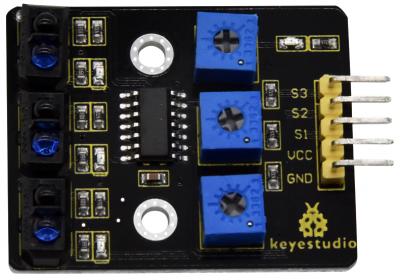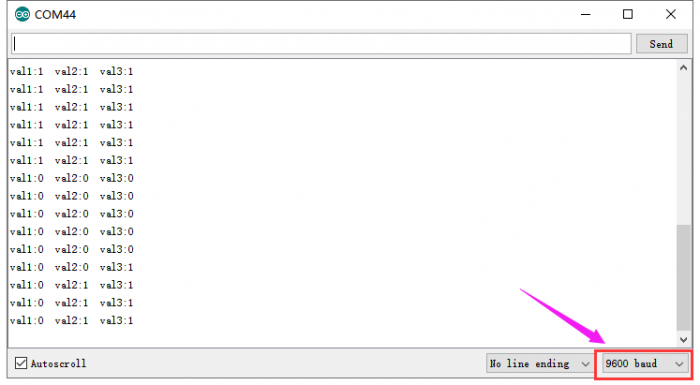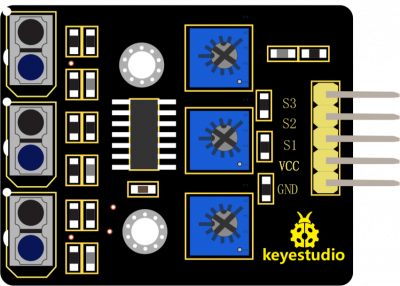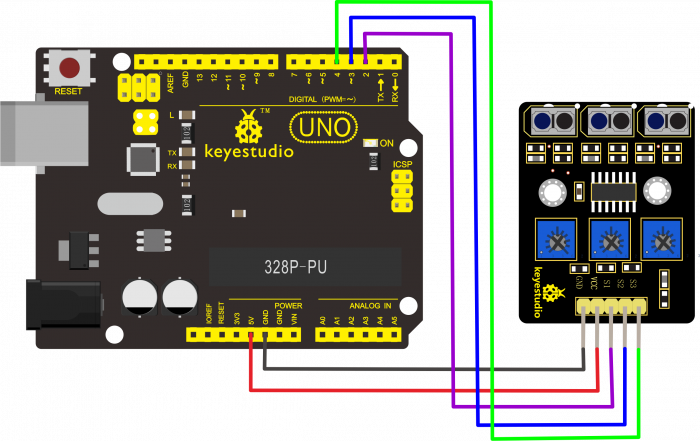KS0453 Keyestudio 3-channel Line Tracking Module: Difference between revisions
Keyestudio (talk | contribs) |
Keyestudio (talk | contribs) |
||
| Line 74: | Line 74: | ||
==Resource== | ==Resource== | ||
*'''Download all the relevant info. from the link:'''<br> | *'''Download all the relevant info. from the link:'''<br> | ||
https://drive.google.com/open?id=186TOcwyeUoJWo83tOuWQ_Tjm1VeeWwOA | |||
<br> | <br> | ||
==Buy from == | ==Buy from == | ||
*[ '''Official Website'''] | *[ '''Official Website'''] | ||
Revision as of 09:19, 5 July 2019
Description
In the smart car DIY process, we often use a line tracking sensor to make the smart car follow a line.
The keyestudio 3-channel line tracking module actually is an infrared sensor. The component used is a TCRT5000 infrared tube.
The working principle is to use the different reflectivity of infrared light to color, converting the strength of the reflected signal into a current signal.
During the detection, black is active at HIGH level, and white is active at LOW. The detection height is 0-3 cm.
We have integrated three groups of TCRT5000 infrared tubes on a single board, convenient for wiring and control.
Turn the adjustable trimpot to adjust the module’s sensitivity.
The module comes with two 3mm positioning holes for mounting on other devices.
Note: before testing, turn the potentiometer to adjust the sensitivity. The sensitivity is the best when make the LED at the threshold point between ON and OFF.

Technical Parameters
- Operating voltage: DC 3.3-5V
- Detection height: 0—3cm
- Interface: 5pin of 2.54mm pitch
- Positioning hole diameter: 3mm
- Dimensions: 42mm*31mm*7mm
- Weight: 6.6g
- Environment attribute: ROHS
Wiring Diagram
Test Code
int sensor1 = 2;
int sensor2 = 3;
int sensor3 = 4;
int val1;
int val2;
int val3;
void setup()
{
Serial.begin(9600);
pinMode(sensor1, INPUT); // set sensor to input mode
pinMode(sensor2, INPUT); // set sensor to input mode
pinMode(sensor2, INPUT); // set sensor to input mode
}
void loop()
{
val1=digitalRead(sensor1);
Serial.print("val1:");
Serial.print(val1);
val2=digitalRead(sensor2);
Serial.print(" val2:");
Serial.print(val2);
val3=digitalRead(sensor3);
Serial.print(" val3:");
Serial.println(val3);
delay(200);
}
Test Result
Done uploading the code to control board, open the serial monitor and set the baud rate to 9600.
When the tacking module detects black line, output 1; detecting white line, output 0. As figure shown below.

Resource
- Download all the relevant info. from the link:
https://drive.google.com/open?id=186TOcwyeUoJWo83tOuWQ_Tjm1VeeWwOA
Buy from
- [ Official Website]

